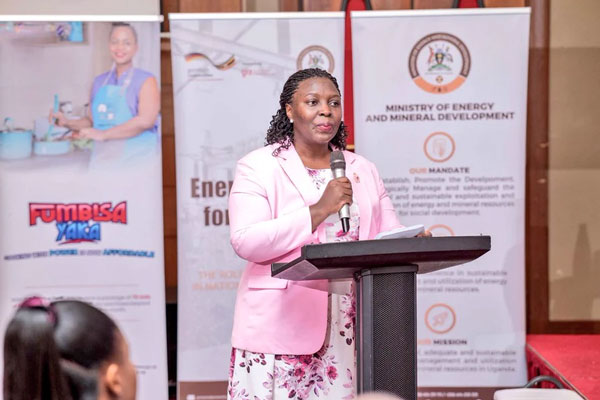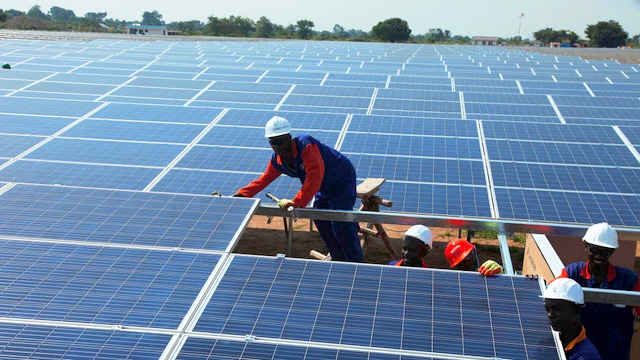
Kampala, Uganda | THE INDEPENDENT | At the end of this month, Uganda through the Ministry of Energy will launch the country’s energy transition strategy at the UN Climate Change Conference (COP2) in the United Arab Emirates.
The proposed launch of Uganda’s Energy Transition plan has been described as a step in the right direction by some climate and environment activists as the world grapples with the urgent need to combat climate change and transition to sustainable energy sources.
The energy transition strategy will act as a blue-print for Uganda on how it will generate, distribute, and consume clean energy sources and possibly when to abandon the fossil fuels in the country’s energy mix. Uganda, which is about to start producing oil is among other countries under international watch by anti-fossil fuel activists.
With this new transition strategy, Uganda has started the journey to move away from fossil-fuel-backed production, or what is generally referred to as decarbonizing.
The strategy, developed by the Ministry of Energy with the collaboration of the International Energy Agency (IEA), also talks about how to decarbonize and absorb more renewable energy sources in mining and petroleum operations. It outlines how the country will achieve the objectives of carbon neutrality by 2050 while ensuring universal access to electricity by 2040.
The National Energy Policy for Uganda 2023 replaces the previous energy policy, which was adopted in 2002. It provides a detailed list of challenges and policy priorities in most energy subsectors, including electricity, renewable energy, energy efficiency, rural electrification, clean cooking, and nuclear power.
According to Irene Bateebe, the Permanent Secretary in the Ministry of Energy and Mineral Development, Uganda currently boasts a largely decarbonized hydropower sector.
“ 80% of our power is hydro-based at about 1600 megawatts out of about 2000 installed capacity by the end of this year,” she said.
Uganda also produces some power from bagasse (sugarcane waste) contributing about 111 megawatts of power from cogeneration. The solar utility plants across the country contribute about 100 megawatts to the grid.
The thermal power plants according to Bateebe are not running on a daily basis as they used to when the country faced severe load shedding. “This is largely run as a security backup. We only call on our thermal when there is a shortfall in the system,” said Bateebe.
Electricity accounts for only 2% of the total final energy consumption, with biomass and fossil fuels accounting for 88% and 10% respectively.
What is in the Energy Transition Strategy?
The strategy is based on Uganda’s ambitious plan to develop industrialize and meet the energy security plan as per the new energy launched this year.
By 2040, Uganda plans to generate about 52000 megawatts of electricity. In real terms, that means that Uganda today is able to aggregate about 28000 megawatts excluding nuclear.
“So we are able to draw all our potential on the hydro side where we still have 4500 megawatts untapped, we have some geothermal about 1550 megawatts, we have some wind, solar and biomass. But we are able to generate up to 28000 megawatts,” Bateebe revealed.
“So the shortfall between 52000 megawatts and 28000 megawatts shall be covered by nuclear 24000 megawatts. I know one will say we are ambitious with nuclear but that is the reality as we set to decarbonize,” Bateebe observed.
Some experts have however urged Uganda against its plans for atomic energy or nuclear power plants.
In September, the German Ambassador to Uganda Matthias Schauer said that with cheaper and abundance of cleaner hydropower and solar energy options, Uganda doesn’t need to invest in environmentally risk nuclear power plants.
Schauer, whose country continues to support Uganda’s clean energy projects and policies, said nuclear power generation is not only costly but environmentally sensitive.
By the end of October 2023, about 30 countries including Uganda were considering, planning, or starting nuclear power programmes. Others in west, central and southern Africa: Nigeria, Ghana, Senegal, Kenya, Tanzania, Zambia, Namibia, Rwanda, and Ethiopia.
The World Nuclear Association indicated that despite the large number of these emerging countries, they are not expected to contribute very much to the expansion of nuclear capacity in the foreseeable future; the main growth will come in countries where the technology is already well-established.
However, in the longer term, the trend to urbanization in less-developed countries will greatly increase the demand for electricity, and especially that supplied by base-load plants such as nuclear. The pattern of energy demand in these countries will become more like that of Europe, North America, and Japan.

The nuclear energy option
The debate about nuclear energy has been on since COP27 in Egypt as the search for energy diversification took a more frantic pace amidst the global energy transition debate. Uganda is among the countries that supported the IEA’s Nuclear Power and Secure Energy Transitions report, which observed a growing appetite for nuclear power.
The IEA supported the development of the Uganda 2023 Energy Policy Review, which details the country’s energy options including nuclear. “Non-fossil fuels, particularly nuclear and hydropower, make a substantial contribution to the energy supply diversity of IEA countries as a group,” reads part of the review prefaced by Dr. Fatih Birol Executive Director International Energy Agency.
The government has a scenario to develop a 1,000 MW nuclear power plant by 2031 and another 1,000 MW plant by 2040 in anticipation of rising demand. It is working with the International Atomic Energy Agency (IAEA), considered to be in Phase 2 of the IAEA Milestone Approach, and has signed non-binding agreements with companies in China and Russia to explore options.
In August 2023, Ugandan President Yoweri Museveni announced that Russia and South Korea had been selected to build two nuclear power plants with a combined capacity of 15 GWe as part of Uganda Vision 2040 roadmap. Potential nuclear reactor sites in the Kyoga, Kagera, and Aswa regions. But Irene Bateebe in the past hinted at Buyende. The base case scenario is for two 1000 MWe units by 2031 with an expected cost of $9 billion.
The challenges related to nuclear and generally grid extension infrastructure. In October 2023, the World Nuclear Association raised some issues related to the deployment of nuclear with the existing grids. Those issues should concern Uganda too as it plans to deploy atomic energy.
Many nuclear power plants are larger than the fossil fuel plants they supplement or replace, and it does not make sense to have any generating unit more than one-tenth of the capacity of the grid (maybe 15% if there is a high reserve capacity,” the World Nuclear Association observed. The Association said Kenya sought to evaluate its grid system before considering the generation options.
According to the association, another issue is that of licensing reactor designs. “Emerging countries generally do not have the expertise for this, and must initially rely on design licensing by countries such as the UK, USA, France, Russia, and China while they focus on building competence to license the actual operation of plants,”
A source at the Ministry of Energy told URN that with lessons from Germany which is currently closing down its nuclear plants for safety concerns, the government is looking at deploying generation 3+ latest technologies which have a life span of 80 and can be increased to 100 years of operation. “So we are looking at energy security. And that offers you reliable power with capacity factors of 80%” the source told URN.
In Uganda, electricity accounts for only 2% of the total final energy consumption, with biomass and fossil fuels accounting for 88% and 10% respectively. The UETCL’s 2018 Grid Development Plan uses Vision 2040’s consumption goals as one scenario but provides a base case under which the required capacity is expected to reach 3 536 MW by 2040, or about 2.5 times the current capacity.
This scenario does not include nuclear, but a generation mix that continues to be dominated by hydropower (73%), followed by solar and wind (together 20%), geothermal (3%), bagasse-fired co-generation (2%), and oil-fired thermal (2%) (UETCL, 2018.
The inadequate transmission and distribution system continues to be a significant constraint on the full use of the country’s generating capacity and has resulted in high costs for the UETCL in take-or-pay contracts.
The grid capacities of intermediate distribution networks are often insufficient to fully transmit power from distributed power generation plants to demand centers. A study by Bernard Wabukala and others last year noted that the availability of a source of electricity does not translate into full access; electricity needs to be available at the right time, at an affordable price, and with a reliable supply. Uganda’s installed capacity is 1269 MW against a peak load of 758 MW.
It observed that a comparison of that supply and demand imbalance translates into a popular belief that Uganda has an excess supply of electricity and, could lead to a loose conclusion that the country is “electricity secure.” So from the researchers, in terms of availability, the surplus exists because only 42% of the population has access to grid electricity.
“Even then, most of the population connected to grid electricity use it to supplement other energy resources. Second, the country continues to experience perennial power outages, blamed on a multitude of factors, including system breakdowns due to natural hazards, an aging electricity infrastructure, electricity theft, and vandalism of transmission and distribution infrastructure.”
This month another study titled “Effects of technical and security factors on grid electricity reliability: evidence from Uganda National Electricity Grid Network” by researchers from Makerere University Business School and the Norwegian University of Life Science found that technical and security factors influenced the transmission and distribution grid electricity reliability in one way or another.
“Technical factors relate to the quality and age of the grid. If the components that make up the power grid are of low quality, this will compromise grid reliability to a great extent because low-quality grid equipment will easily break or fail.”
It means that from now up to 2040, the energy infrastructure landscape will undergo a profound transformation. Irene Bateebe agreed that in a bid to achieve its Sustainable Development Goals (SDGs) for universal access by 2030, it must invest.
“And today on the access side, looking at just distribution, we need up to $5 billion to achieve our universal access agenda,” said Bateebe
Tuzinde Mbaga, the Head of Regulatory at UmemeLtd Uganda’s main electricity distribution company estimated that Uganda may require $120 million per year in the distribution segment. “It means that government should come in and invest. So that there is a mix between private capital and money from the government gives you the right tariff,” said Mbaga.
Experts in electricity distribution told URN that without a robust and flexible grid infrastructure, Uganda may face challenges in maximizing the potential of renewable energy generation.
*****
This three-part URN article brings to light some of Uganda’s plans for the energy transition and explores the possibilities for energy infrastructure based on the global developments in the energy sector. We shall explore the energy transition from oil and gas developments. The final parts will look at transition minerals as we explore some of the barriers that could prevent these developments and what the country needs to overcome to fulfill its clean energy ambitions.
 The Independent Uganda: You get the Truth we Pay the Price
The Independent Uganda: You get the Truth we Pay the Price


